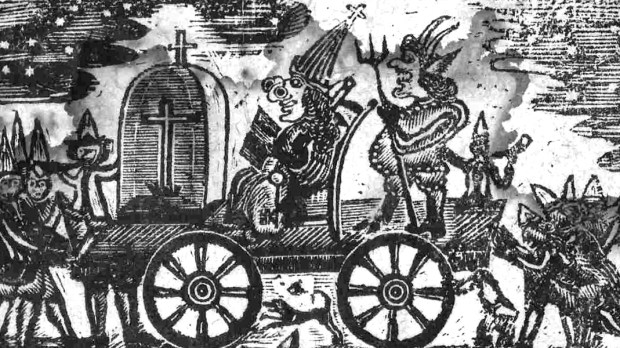Lenten Campaign 2025
This content is free of charge, as are all our articles.
Support us with a donation that is tax-deductible and enable us to continue to reach millions of readers.
Plymouth, Massachusetts, is thought by many to be the site of America’s first Thanksgiving meal. It has another first, one that not many people talk about, as it gives the town a rather dubious distinction.
The place where the Mayflower Pilgrims landed and founded the first colony in 1620 became the first town to hold what was known as Pope Night, just three years later. It was far from a celebration of the Bishop of Rome, and today, when so many old stereotypes are being called into question, it would surely appear as a black mark on American history.
Pope Night was a vehicle for expressing anti-Catholic sentiment even more than Guy Fawkes Day, which was its inspiration. The latter, commemorated every Fifth of November in England, recalled the failed attempt of Catholic plotters, including Guy Fawkes, to blow up the House of Lords in London.
By the 1770s, just before the American Revolution, Pope Night had taken on so many traditions that it was difficult for participants, especially in Boston, to give it up. Eventually, however, some of those traditions morphed into a much more benign celebration that we now know as Halloween.
“Plymouth, Mass., celebrated the first recorded Pope Night in 1623 when sailors lit a bonfire,” says an article on the website of the New England Historical Society. “The fire blazed out of control and burned down several nearby homes. That was so much fun the other seacoast towns took up the celebration. Pope Night spread to Marblehead, Newburyport and Salem in Massachusetts, Portsmouth in New Hampshire and New London in Connecticut. The festivities generally featured fires, drinking and mockery of elites and authorities.”
In general, the celebration’s essential elements were parades of floats carrying effigies of the pope, which were burned, followed by a lot of partying. In Boston, there was not one but two parades — one beginning in the city’s North End, the other in the South. When the two groups met, the competition became violent, with gangs from each part of the city engaging in fistfights and swinging bats at each other. Some of these encounters actually got so bad that they left fatalities.
“The winning side would take the cart, the money and the effigies of the loser, then burn the effigies in a bonfire and spend the money on a feast,” the historical society said, noting that Boston had only a “handful” of constables, so the brawling was virtually unstoppable.
Interestingly, it was political considerations that led to a toning-down of the “celebrations.” In their efforts to break free of Great Britain, the American Colonies needed support from allies and internal unity. How could the Revolution’s leaders expect to gain support from Catholic France and French-Canadian neighbors, and to get Catholic Maryland on board with the cause, when some colonial residents were allowed to carry on this anti-Catholic demonstration year after year?
In 1775, while headquartered in Cambridge, Mass., Continental Army Commander in Chief George Washington “put a stop to Pope Night,” the historical society said. “He called it ‘that ridiculous and childish custom of burning the Effigy of the pope.’ He called it improper ‘at a time when we are soliciting, and have really obtained the friendship and alliance of the people of Canada.’” After a couple of years, “even the revelers realized it would have been unseemly to mock the religion of the king who sent the money, men and arms that won the American Revolution,” and Pope Night died out.
But vestiges remained, particularly the bonfires and the custom of boys going door to door asking for goodies. “The tradition evolved into ‘Pork Night,’ the society wrote. The practice was “moved up a few days” to October 31, and became what we now know as Halloween.

